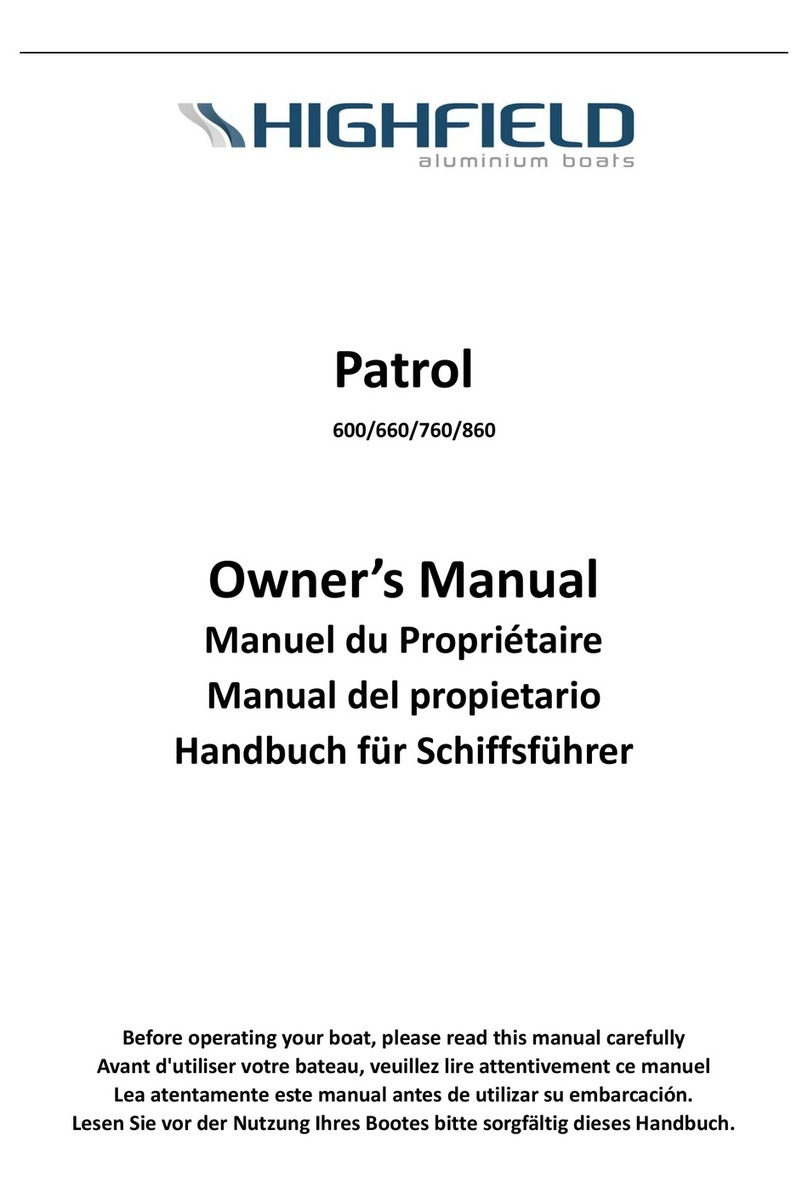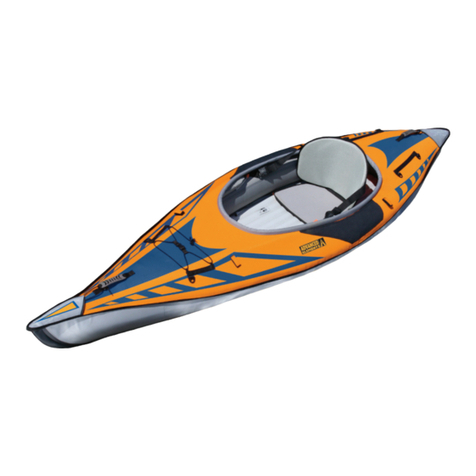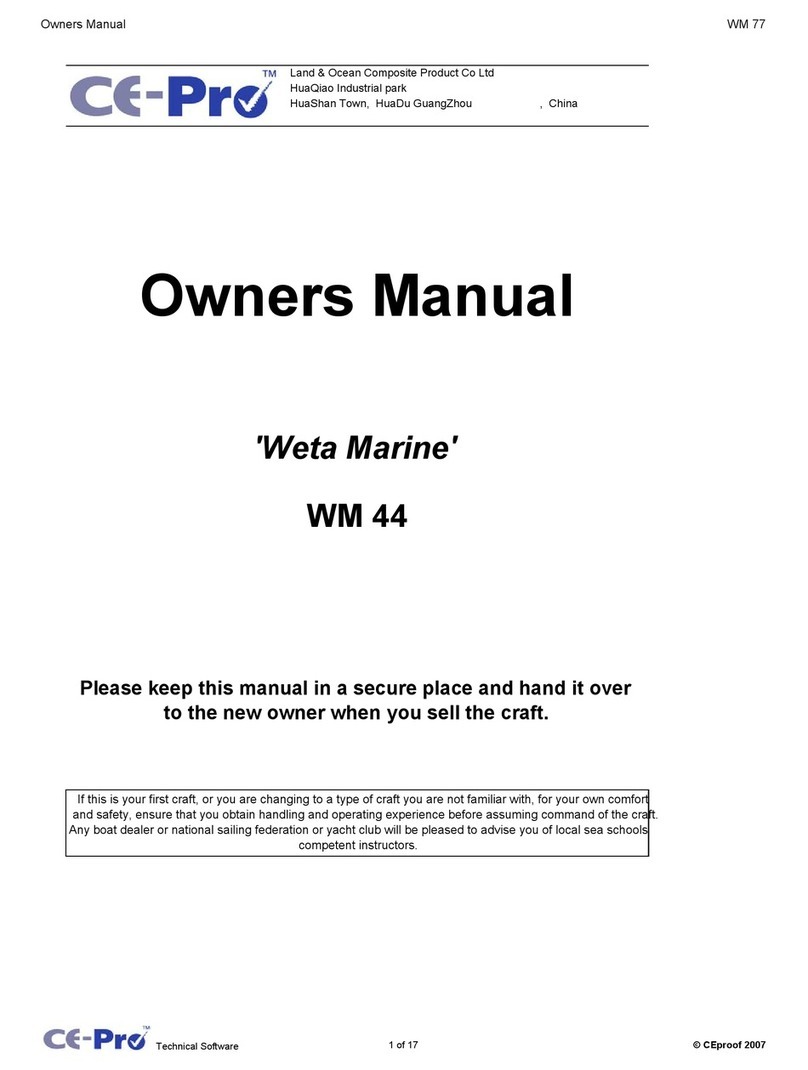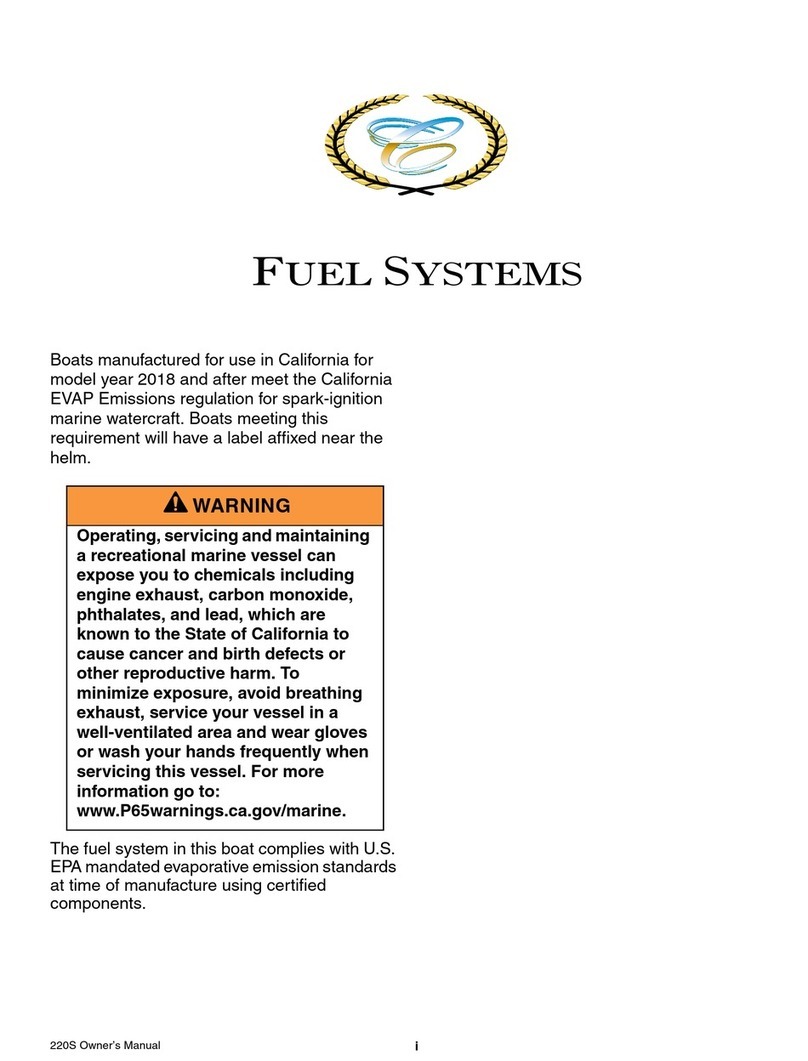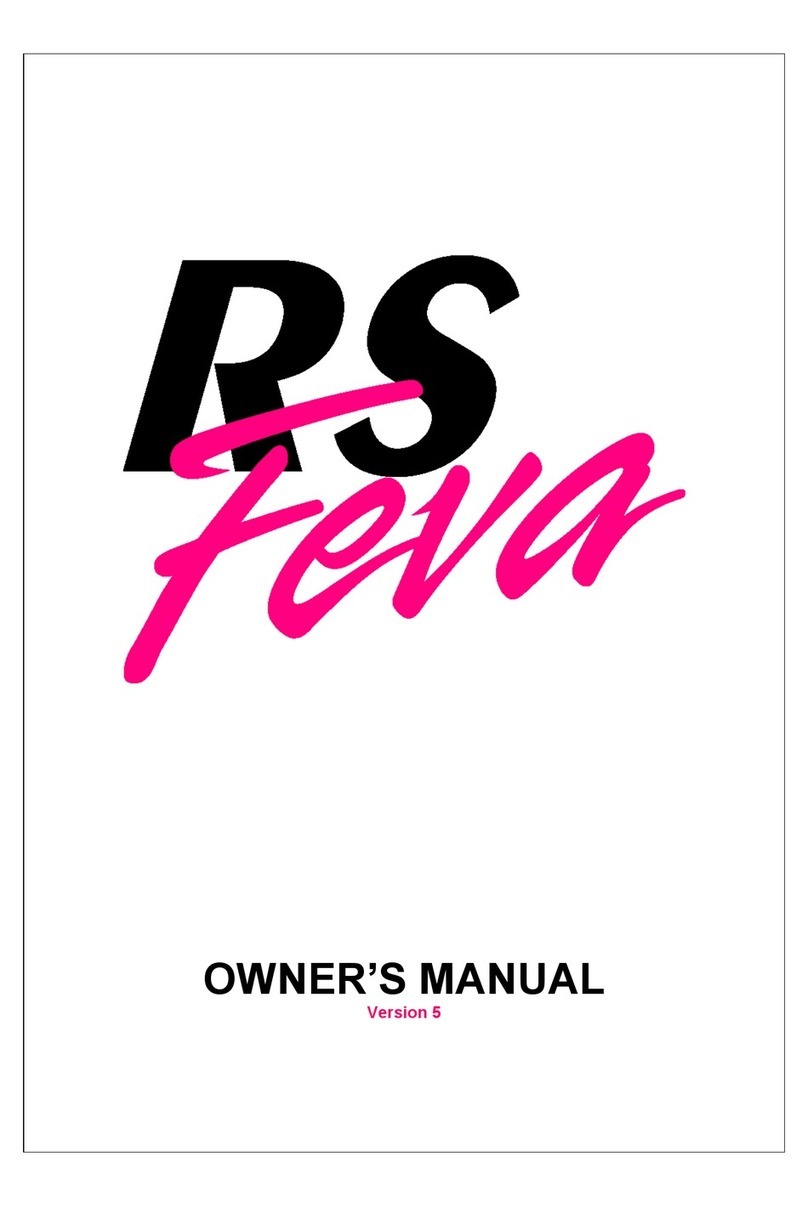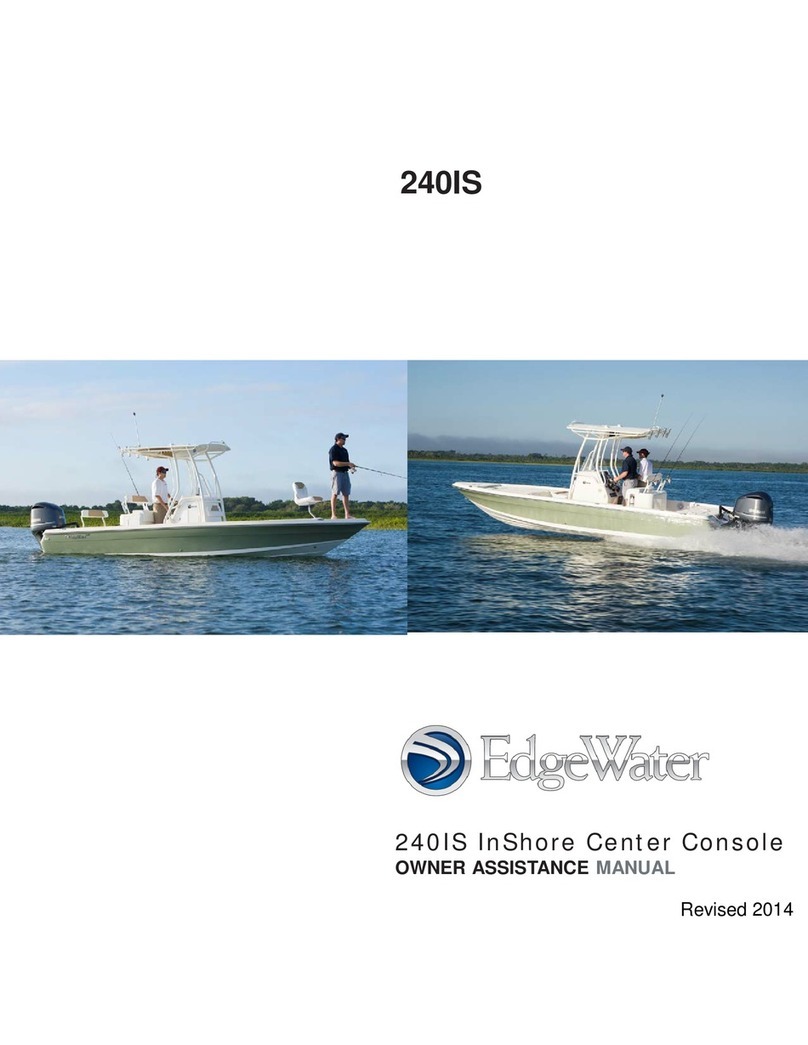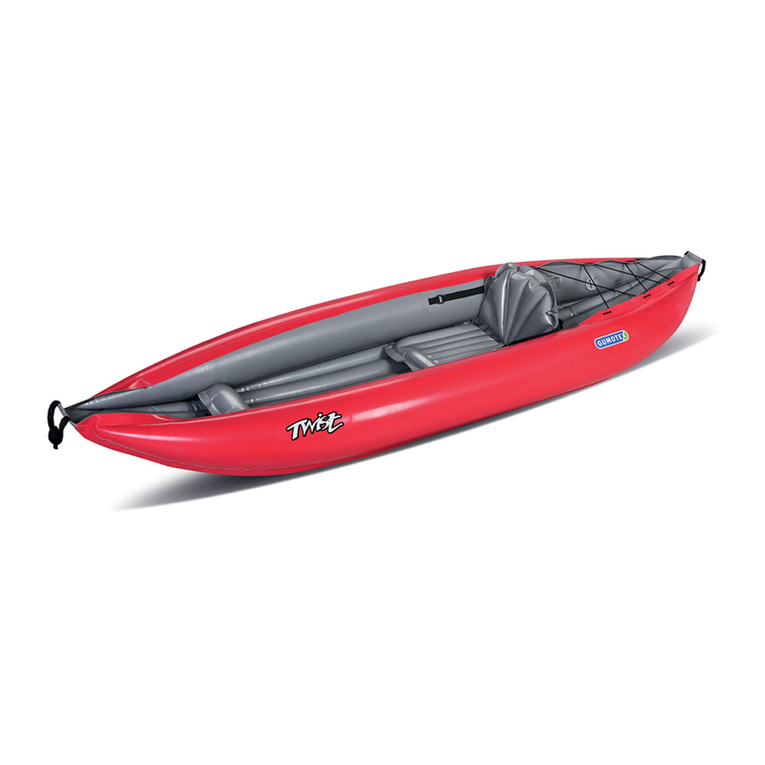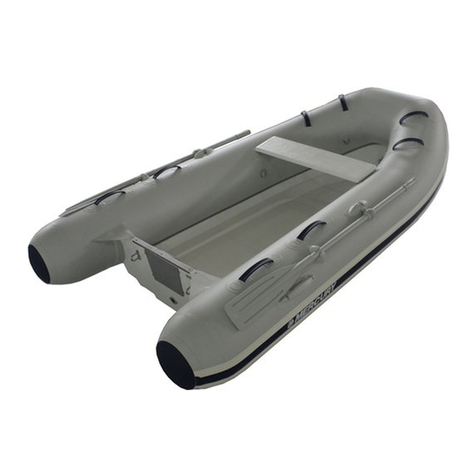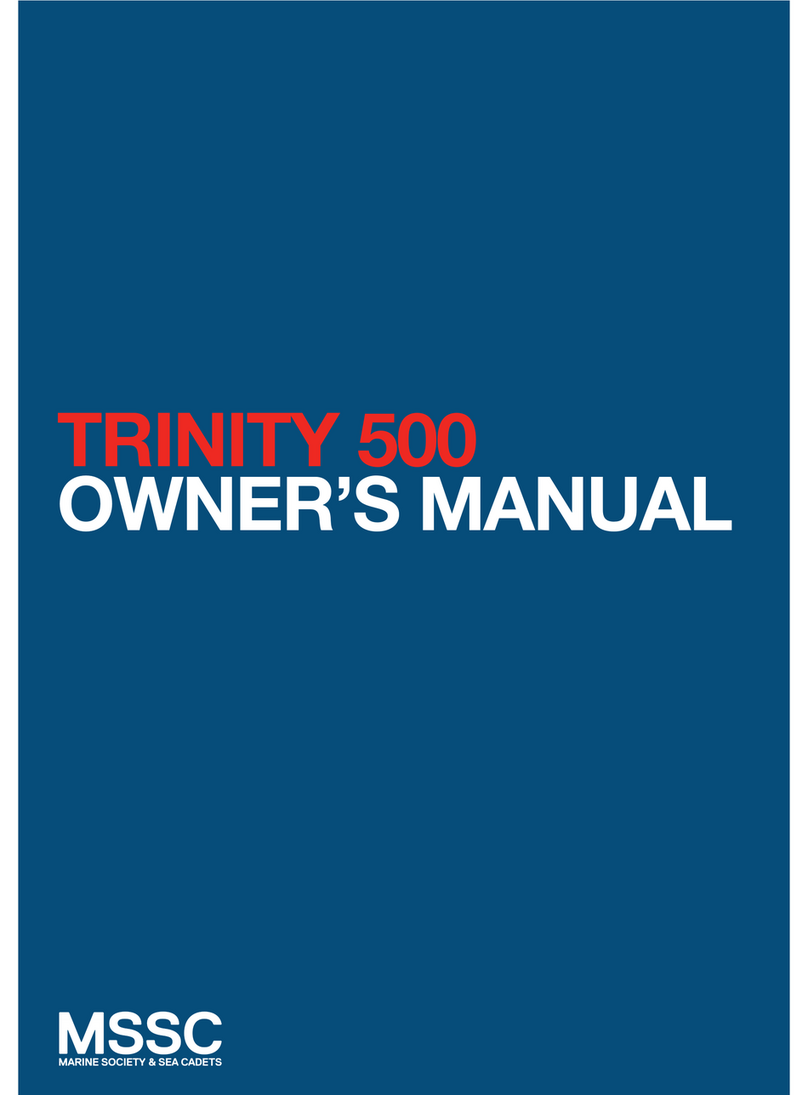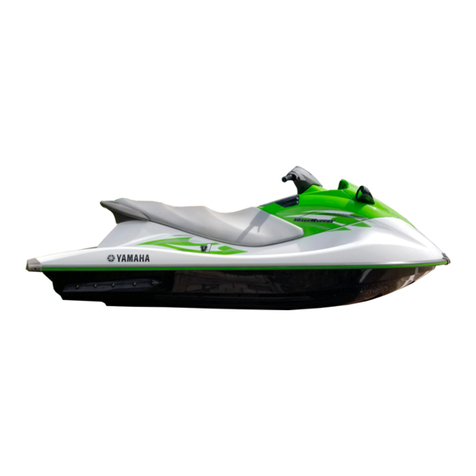Highfield Ocean Master 350 User manual

Ocean Master
350/390/420/460/500/540/590
Deluxe
350/390/420/460/500/540/590/640
Owner’s Manual
Before operating your boat, please read this manual carefully
PLEASE KEEP THIS MANUAL IN A SECURE PLACE, AND HAND IT OVER TO THE NEW
OWNER WHEN YOU SELL THE BOAT.

Content
General Introduction ................................................................................................................................................. 3
Safety alerts ............................................................................................................................................................... 4
Safe Boating Recommendations................................................................................................................................ 4
Pre-operation check list............................................................................................................................................. 5
Specifications: Ocean Master .................................................................................................................................... 6
General Arrangement ............................................................................................................................................ 6
Specifications: Ocean Master .................................................................................................................................... 7
General Arrangement ............................................................................................................................................ 7
Specifications: Deluxe................................................................................................................................................ 8
General Arrangement ............................................................................................................................................ 8
Specifications: Deluxe................................................................................................................................................ 9
General Arrangement ............................................................................................................................................ 9
Recommended Seating Arrangement (Ocean Master)............................................................................................ 11
Recommended Seating Arrangement (Deluxe) ....................................................................................................... 12
Builder’ Plate: .......................................................................................................................................................... 13
Fuel System.............................................................................................................................................................. 13
Information connected with the risk of flooding and stability ................................................................................ 14
Information connected with the risk of fire or explosion........................................................................................ 17
Electrical Systems .................................................................................................................................................... 19
Transporting............................................................................................................................................................. 20
Engine Start.............................................................................................................................................................. 20
Operation................................................................................................................................................................. 21
Man-overboard prevention and recovery ............................................................................................................... 24
Maintenance............................................................................................................................................................ 25
Warranty.................................................................................................................................................................. 28
Service assistance .................................................................................................................................................... 29

To ensure that you gain maximum satisfaction from your Highfield boat, please
read this Owner’s Manual carefully. It contains all the safety and operation
instructions that you need to get the most out of your new Highfield.
General Introduction
This manual has been compiled to help you to operate your boat with safety and pleasure. It contains
details of the boat; the equipment supplied or fitted; its systems and information on their operation. Please read
it carefully, and familiarize yourself with the boat before using it.
This owner's manual is not a course on boating safety or seamanship. If this is your first boat, or if you are
changing to a type of boat you are not familiar with, for your own comfort and safety, please ensure that you
obtain handling and operating experience before “assuming command” of the boat. Your dealer or national
sailing federation or yacht club will be pleased to advise you of local sea schools, or competent instructors.
Ensure that the anticipated wind and sea conditions will correspond to the design category of your boat,
and that you and your crew are able to handle the boat in these conditions.
Even when your boat is categorized for them, the sea and wind conditions corresponding to the design
categories A, B and C range from severe storm conditions for category A, to strong conditions for the top of
category C, open to the hazards of a freak wave or gust. These are therefore dangerous conditions, where only a
competent, fit and trained crew using a well maintained boat can satisfactorily operate.
This owner's manual is not a detailed maintenance or trouble-shooting guide. In the case of difficulty, refer
to the boat builder or his representative. If a maintenance manual is provided, use it for the boat's maintenance.
Always use trained and competent people for maintenance, fixing or modifications. Modifications that may
affect the safety characteristics of the boat shall be assessed, executed and documented by competent people.
The boat builder cannot be held responsible for modifications that he has not approved.
In some countries, a driving license or authorization is required, or specific regulations are in force.
Always maintain your boat properly and make allowance for the deterioration that will occur in time and as
a result of heavy use or misuse of the boat.
Any boat, no matter how strong it may be, can be severely damaged if not used properly. This is not
compatible with safe boating. Always adjust the speed and direction of the boat to sea conditions.
If your boat is fitted with a life raft, carefully read its operating manual. The boat should have onboard the
appropriate safety equipment (lifejackets, harness, etc.) according to the type of boat, weather conditions, etc.
This equipment is mandatory in some countries. The crew should be familiar with the use of all safety equipment
and emergency maneuvering (man overboard recovery, towing, etc.), sailing schools and clubs regularly organize
drill sessions.
All persons should wear a suitable buoyancy aid (life jacket/personal floatation device) when on deck. Note
that, in some countries, it is a legal requirement to wear a buoyancy aid that complies with their national
regulations at all times.

Safety alerts
This manual uses the following safety alerts to draw your attention to special safety instructions that should be
followed.
Degree of hazard and corresponding safety labels:
Danger
Denotes that an extreme intrinsic hazard exists which would result in high probability of death or irreparable
injury if proper precautions are not taken.
Warning
Denotes that an extreme intrinsic hazard exists which would result in high probability of death or irreparable
injury if proper precautions are not taken.
Caution
Denotes that an extreme intrinsic hazard exists which would result in high probability of death or irreparable
injury if proper precautions are not taken.
Safe Boating Recommendations
1. Always wear a life jacket
Local authorities require that you carry an approved personal flotation device, or life jacket, for each person
aboard your vessel. We recommend wearing a life jacket at all times while boating.
2. Use the kill switch lanyard
The operator of the boat must at all times wear a switch lanyard while driving. In the event of accidental
ejection or loss of balance, the boat will shut off automatically. Wearing a switch lanyard would possibly saving
the driver’s life or that of someone else.
3. Know your boat
Knowing your boat is the foundation of good seamanship, which is simply the skill of managing a boat and
encompasses; navigation, safety, boat handling, line handling, anchoring, troubleshooting of engine problems
and appropriate emergency response.
4. Take a boating safety course and know the navigation rules
A boating course will teach you the basics of seamanship mentioned above. The knowledge you will gain by
taking a boating safety course will never be wasted. Learn to read nautical charts, and keep them on your vessel
to become familiar with the area in which you boat. Taking a boating safety course is the next step, where you
will learn to navigate using charts, GPS, RADAR and a compass.
5. Boat sober
Alcoholic drinks are even more dangerous on the water than on land because the marine environment
accelerates impairment. Besides the safety risks, boating while intoxicated, or BUI, is illegal and heavy penalties
are enforced by both state and federal agencies.
6. Avoid collisions.
Observe the rules of priority as defined in the Navigation Rules and imposed by the international regulations
for preventing collisions at sea. Ensure that you always have sufficient room to stop or manoeuver if necessary in
order to avoid a collision. Avoid abrupt maneuvers at full speed.
7. Protect people

Always slow down and exercise extreme caution any time you are boating in area where there are people in
the water.
8. Respect for environment
Please be aware of local environment laws and international regulations against marine pollution and respect
them as much as possible.
9. Control Speed
Do not drive at top speed in areas of heavy boat traffic or in situations of reduced visibility, strong winds or
heavy seas. Reduce the boat’s speed in big waves and wake out of courtesy and for your own safety and the
safety of others. Observe speed limits and “NO WASH”signs.
10. Others:
Do not sit in the bow cockpit when the boat is moving at high speed.
Danger
When operating, passengers must avoid standing up or hanging appendage outside of the boat. Leaking fuel is a
fire hazard, inspect fuel system regularly. Shut off the engine before boarding from the water.
Warning
Shall the operator or passenger fall out of the boat, the possibility of serious injury or death from being run over
by the boat can be greatly reduced by stopping the engine immediately. Always properly connect both ends of
the stop switch lanyard to the stop switch and the operator.
Caution
Passengers must use suitable PFDs. Special PFDs are designed for children or watersport activities. (Personal
Flotation Device)
Pre-operation check list
a). Make sure you every passenger is wearing a suitable personal flotation device.
b). Make sure there is an extra buoyant device that can be thrown to rescue person in the water.
c.) If boating with passengers, instruct at least on passenger in the basics of boat handling, staring and operation
of the outboard motor.
d). Check that every passenger is securely seated and hold a safe line, grab handle or rope.
e). Make sure that there is a 4m towing rope in the boat.
f). Make sure the load in the boat is distributed evenly.
g). Make sure you respect the maximum load specified for the boat as described on the manufacturer’s plate.
h). Make sure that all safety gears is on board, e.g. whistle, floating ropes, waterproof flashlight, first aid kit, fresh
water, tool kit…
i). Check that the boat is equipped with 2 paddlers or oars.
j). Make sure the outboard motor is securely fastened to the transom.
k). Make sure the drain plug is fully functional.
l). Check the pressure level in each chamber using a pressure gauge. Recommended working pressure is
displayed on manufacturer’s plate.
m). Check fuel tank level and make sure it suits your plan.
n). Start the outboard motor and make sure it stops when the lanyard is disconnected from the switch.

Specifications: Ocean Master
Description
OM Models
350
390
420
460
Hull Construction Material
5 series marine grade aluminum alloy
Deck Construction Material
5 series marine grade aluminum alloy
Tube Material
PVC or Hypalon coated fabrics
Overall Length
a
3.5m
3.9m
4.2m
4.6m
Inside Length
c
2.62m
3.0m
3.26m
3.65m
Beam
b
1.85m
1.85m
2.1m
2.1m
Inside Width
d
0.94m
0.94m
1.08m
1.08m
Bow Height
e
942mm
953mm
1012mm
1013mm
Stern Height
f
612mm
612mm
666mm
667mm
Dead Rise
20o
20o
20o
20o
Airtight Chambers
3
3
4
5
Light displacement without
engine
115Kg
254lb
150.6
Kg
332lb
263.6
Kg
581lb
297.6Kg
656lb
Max Passenger
6
7
8
9
Max Load
603Kg
1329lb
678Kg
1495lb
771Kg
1700lb
901Kg
1986lb
Main Propulsion
Motor
Max Engine Power
40HP
29.4KW
50HP
36.75KW
60HP
44.10KW
80HP
58.80KW
Engine Shaft
L
L
L
L
Design Category
C
C
C
C
Tube Diameter
470mm
470mm
470mm
470mm
Max Engine Weight
100Kg
100Kg
110Kg
165Kg
Fuel Tank Capacity
30L
30L
40L
40L
General Arrangement

Specifications: Ocean Master
Description
OM Models
500
540
590
Hull Construction Material
5 series marine grade aluminum alloy
Deck Construction Material
5 series marine grade aluminum alloy
Tube Material
PVC or Hypalon coated fabrics
Overall Length
a
5.0m
5.4m
5.9m
Inside Length
c
4.155m
4.36m
4.83m
Beam
b
2.28m
2.38m
2.44m
Inside Width
d
1.2m
1.3m
1.3m
Bow Height
e
1141mm
1130mm
1170mm
Stern Height
f
744mm
780mm
780mm
Dead Rise
24o
24o
24o
Airtight Chambers
6
6
6
Light displacement without
engine
419.7Kg
925lb
474.6Kg
1046lb
568.6Kg
1254lb
Max Passenger
10
12
14
Max Load
1008Kg
2204lbs
1223Kg
2696lbs
1498Kg
3303lbs
Main Propulsion
Motor
Max Engine Power
100HP
74.6KW
115HP
85.76KW
150HP
111.85KW
Engine Shaft
L
XL
XL
Design Category
C
C
C
Tube Diameter
520mm
520mm
550mm
Max Engine Weight
165Kg
220Kg
220Kg
Fuel Tank Capacity
90L
105L
120L
General Arrangement

Specifications: Deluxe
Description
DL Models
350
390
420
460
Hull Construction Material
5 series marine grade aluminum alloy
Deck Construction Material
5 series marine grade aluminum alloy
Tube Material
PVC or Hypalon coated fabrics
Overall Length
a
3.5m
3.9m
4.2m
4.6m
Inside Length
c
2.15m
2.55m
2.6m
3.0m
Beam
b
1.89m
1.89m
2.1m
2.1m
Inside Width
d
0.92m
0.92m
1.08m
1.08m
Bow Height
e
961mm
961mm
1024mm
1034mm
Stern Height
f
595mm
595mm
666mm
666mm
Dead Rise
20o
20o
20o
20o
Airtight Chambers
3
3
4
5
Light displacement without
engine
180Kg
397lb
210.6Kg
464lb
263.6Kg
581lb
295.6Kg
652lb
Max Passenger
6
7
8
9
Max Load
680Kg
1499lb
780Kg
1720lb
850Kg
1874lb
900Kg
1984lb
Main Propulsion
Motor
Max Engine Power
40HP
29.4KW
50HP
36.75KW
60HP
44.10KW
80HP
58.80KW
Engine Shaft
L
L
L
L
Design Category
C
C
C
C
Tube Diameter
470mm
470mm
470mm
470mm
Max Engine Weight
100Kg
100Kg
110Kg
165Kg
Fuel Tank Capacity
30L
30L
40L
40L
General Arrangement

Specifications: Deluxe
Description
DL Models
500
540
590
640
Hull Construction Material
5 series marine grade aluminum alloy
Deck Construction Material
5 series marine grade aluminum alloy
Tube Material
PVC or Hypalon coated fabrics
Overall Length
a
5.0m
5.4m
5.9m
6.4m
Inside Length
c
3.4m
3.7m
4.25m
4.6m
Beam
b
2.3m
2.38m
2.44m
2.45m
Inside Width
d
1.2m
1.3m
1.3m
1.3m
Bow Height
e
1141mm
1130mm
1170mm
1307mm
Stern Height
f
744mm
780mm
780mm
833mm
Dead Rise
24o
24o
24o
24o
Airtight Chambers
6
6
6
6
Light displacement without
engine
483.06
Kg
1065lb
519.6
Kg
1146lb
579.6
Kg
1278lb
651.6
Kg
1437lb
Max Passenger
10
12
14
16
Max Load
1000Kg
2205lb
1200Kg
2645lb
1400Kg
3086lb
1724Kg
3801lb
Main Propulsion
Motor
Max Engine Power
90HP
73.5
KW
115HP
84.53
KW
145HP
102.9
KW
175HP
128.63
KW
Engine Shaft
L
XL
XL
XL
Design Category
C
C
C
C
Tube Diameter
520mm
520mm
550mm
550mm
Max Engine Weight
180Kg
220Kg
280Kg
270Kg
Fuel Tank Capacity
90L
105L
120L
140L
General Arrangement

Notes:
a) Overall Length: Including removable parts that can be dismantled, without affecting the structure of the
boat.
b) Inside Length: Excluding removable parts that can be dismantled, without affecting the structure of the boat.
c) Beam: Including removable parts that can be dismantled, without affecting the structure of the boat.
d) Inside width: Excluding removable parts that can be dismantled, without affecting the structure of the boat.
e) Fuel Tank Capacity: It may not be possible to use this capacity fully depending on the trim and load of the
boat. It is recommended to keep a reserve of 20% in the fuel tanks.
f) Category C: Craft designed to operate in winds up to Beaufort force 6 and the associated wave heights
(significant wave height up to 2m). Such conditions may be encountered in exposed inland waters, in
estuaries, and in coastal waters in moderate weather conditions.(ISO10240)
g) Load distribution
-Please refer to the maximum numbers of passengers and load capacity of the boat in this manual or on
the builder’s plate. Do not exceed the maximum number.
-Position the passengers and distribute the load evenly in the boat to help counterbalance the weight of
the outboard.
-In rough waters, load can be moved forward to ease the motion of the craft.
h) If some of those onboard are children, the total number of people allowed onboard may be increased,
provided that:
-The total weight of the children does not exceed 37.5Kg; and that
-The total weight of all allowed onboard (based on about 75Kg per adult) is not exceeded.
Warning
Do not exceed the maximum recommended number of persons. Regardless of the number of persons on board,
the total weight of persons and equipment must never exceed the maximum recommended load. Always use the
seats/ seating spaces provided.
When loading the boat, never exceed the recommended maximum load. Always load the boat carefully and
distribute loads appropriately to maintain design trim (approximately level). Avoid placing heavy weights high up.
Do not install an engine in this boat with a higher rated power than that indicated on the Builder’s plate as
below.
Do not operate the boat with an engine of rated power greater than the maximum recommended power.
Overpowering a boat can result in serious injury, death or boat damage.
Use negative trim to go from cruising speed to planning speed and at low speeds (applicable to boats equipped
with a system for directing the propeller thrust).
Do no drive the boat at high speed with a negative trim of the propulsion equipment (bow down).

Recommended Seating Arrangement (Ocean Master)
OM350 OM390
OM420 OM460
OM500 OM540
OM590

Recommended Seating Arrangement (Deluxe)
DL350 DL390
DL420 DL460
DL500 DL540
DL590 DL640

Builder’Plate:
Part of the information is given on the builder’s plate affixed on the inside of the boat transom. A full
explanation of this information is given in the relevant sections of this manual.
Notes:
a: Name of manufacturer
b: Model
c: Design category
d: Maximum motor power
e: Maximum number of passengers
f: Maximum load capacity
g: Recommended working pressure
Fuel System
Chart of Fuel System
b
c
d
e
f
g
a

Reference
Designation
1
Anti-flooding valve
2
Fuel filler and tank vent hole
3
Fuel gauge indicator
4
Petrol fuel tank
Information connected with the risk of flooding and stability
1. Openings in the hull
Reference
Designation
1
Ventilation grids
2
Anchor locker
3
Fuel filler
4/10
Drain scupper-cockpit/ deck
5
Engine rigging flange
6/11
Motor well boot
7
Inspection hatch
8
Fuel filler drain
9
Bilge drain plug

Use of drain plug
Reference
Designation
Location
Direction for use
Picture
In water
at rest
In water in
motion
Out of
water
1
Scupper
Transom
N/A
N/A
N/A
2
Bilge drain
plug
Transom
Closed
Closed
Open
3
Cockpit plug
Rear seat
vertical panel
Closed
Open
Open
Caution
Keep the bilge drain plug open when the boat is kept outside of the water. The rain water could fill the boat and
create stress and damage.
Danger
Do not open the bilge drain plug when the boat is afloat.
Do not try to access the bilge drain plug when motor is running. Propeller may cause serious injury.
2. Stability and buoyancy
This boat has been assessed as capable of supported the weight of the crew, even in the event of flooding.
a) Fully laden displacement was used to evaluate the stability and buoyancy of the boat. The value of this
displacement can be found in paragraph “Specifications”as below.
b) Any changes in the distribution of loads onboard (for example by adding a raised structure for fishing, fitting
radar or in-mast furling, changing the engine etc.) can significantly affect the boat’s stability, trim and its
performance.
c) It is important to keep water in the bilges to a minimum.

d) The boat’s stability is affected by adding to the weight of the superstructure.
e) When under way, it is advisable to shut the hatches, lockers and doors to minimize the risk of flooding.
f) The boat’s stability can be reduced when towing a boat or when using a davit or boom to lift a heavy load.
g) Air chambers shall not be punctured.
h) Breaking waves are a serious stability hazard.
Warning
Always adjust the speed and heading of your boat according to the sea conditions.
All of the watertight hatches and bilge drain plug must remain closed when at sea.

Information connected with the risk of fire or explosion
1. Propulsion engine
a) Make sure that the cooling water is circulating properly thru the engine.
b) Ensure that ventilation openings in the compartment fuel tank are not obstructed.
c) Stop the engine and refrain from smoking during fuel tank filling.
d) Get your fuel circuit checked regularly by a professional engineer.
e) Avoid any contact between inflammable materials and the hot sections of the engine.
f) Never switch off or de-energize the electric system when the engine is running.
g) Never block the access of the fuel supply valve.
h) Do not obstruct or modify the ventilation system. Ensure that ventilation ducts are free.
i) Never turn the engine over when the boat is on land.
j) Fuel stored outside the fuel tanks (jerry cans, spare cans) must be kept in a well-ventilated place.
k) Regularly check that the petrol tank compartment is clean and dry.
l) Take all necessary precautions to avoid contact with naked flames and other hot areas.
Diagram of the layout- Ventilation of petrol tank compartment
Warning
Portable fuel tank should be filled outside of the boat.
Always fill tanks in a ventilated area, motor should be turned off.
Do not smoke when filling the tanks.

2. Fire prevention and fire-fighting equipment
(1) Portable fire-extinguishers and fire blanket (not supplied)
a) When in use, this boat must be equipped with portable fire extinguishers of the following extinguishing
capacity and located in the following places.
b) The location of the portable fire extinguishers is shown by the pictogram below:
Location for portable extinguisher
Reference
Designation
Location
Minimum extinguishing capacity
1
Portable extinguisher
seat
8A/6B
Warning
Boats equipped with a 25kW or larger outboard engine must have onboard one or more portable fire
extinguishers with a total combined capacity of at least 86/6B
The fuel tank compartment has a port that makes it possible to inject the extinguishing product inside. The fire
port has been designed so that the nozzle of the portable fire extinguisher can be inserted into it and
extinguishing product discharged into the fuel tank compartment.
Fire port- located on the port side of the console
(2) Servicing of fire-fighting equipment
The boat owner/operator shall:
a) Have fire-fighting equipment checked at the intervals indicated on the equipment.
b) Replace portable fire extinguishers, if expired or discharged, by devices of identical fire-fighting capacity.
c) Have fixed systems refilled or replaced when expired or discharged.
(3) Responsibility of boat owner/operator
a) To ensure that fire-fighting equipment is readily accessible when the boat is occupied.
b) To ensure that any drainage points in the petrol tank compartment are readily accessible.
c) To inform members of the crew about: the location and operation of fire-fighting equipment, the location of
discharge opening into the engine space and the location of routes and exits.
Caution
Keep the bilges clean and check for fuel and gas vapors or fuel leaks frequently. When replacing parts of the
fire-fighting installation, only matching components shall be used, bearing the same designation or having
equivalent technical and fire-resistant capabilities.

Electrical Systems
Danger
The risks of fire or explosion may result from improper use of electric DC and AC systems.
The risks of electric-shock hazards may result from improper use of electric AC system.
Warning
Do not work on a live electrical system.
Do not modify the electrical system of the boat or the relevant diagrams: It is important that the installation,
maintenance and any modifications be carried out by a technician qualified in marine electricity.
Do not change or modify the strength of the safety devices protecting against power surges.
Do not install or replace electrical equipment or materials with components which exceed the system’s nominal
electrical power capacity.
Do not leave the boat unsupervised when the electrical system is live, apart from when the automatic bilge pump
and the boat’s fire protection and security systems are in use.
Item
Description
Quantity
Item
Description
Quantity
①
Circuit-breaker 5025B
1
⑦
Power switch
1
②
Semi-auto switch
1
⑧
Battery
1
③
Manual switch
3
⑨
Collector 2303B
1
④
USB 1039B
1
⑩
Fuel Gauge
1
⑤
Socket 1011B
1
⑪
Engine
1
⑥
Terminal 2406B
1
⑫
Circuit-breaker 5064B
1

Transporting
1. For optimum handling, the trailer must be properly loaded and balanced.
2. Keep the center of gravity low for best handling.
3. Approximately 60 percent of the boat’s weight should be positioned on the front half of the trailer and 40
percent in the rear.
4. The boat should also be balance from side to side. If the vessel has side mounted fuel or water tanks and
only one side is filled, then this will lend the rig to maneuver poorly. Proper balancing will also prolong the
life of your trailers tires.
5. The boat should be firmly secured with at least two ratchet type straps, one attached from the trailer to the
stern eyes and one strap from the trailer, to the bow eye to keep the boat from shifting forward. The bow
eye should also be attached to the trailer’s winch which is mounted forward of the bow. Make sure you have
sufficient clearance to avoid to damage outboard or boat during transportation.
6. Classic models can be accommodated/ transported on a roof rack. We recommend the boat to be protected
from the roof rack that could damage the tube material. Boat should be stowed upside-down. Oars, bench
seat and equipments should be removed from the boat. Boat must be secured using reliable nylon tie-down
straps with cam-buckles. We recommend also tying a small rope off at the bow towing eye for extra safety.
Engine Start
Before starting the engine, it is imperative:
a) To open the fuel supply valve
b) To switch on the battery supply by using the battery isolator switches
c) To put the control lever in neutral
d) To attach the circuit-breaker/ kill switch lanyard to the pilot.
Make sure a habit of looking to see if sea water is pumped out with the exhaust gases as soon as you start
the engine. If no water runs out, stop the engine immediately. Check the coolant flow.
Danger
Before using the engine, make sure you carefully read the handbook provided by the engine manufacturer.
Always start the engine with the control lever in neutral.
Learn how to judge the necessary distance of deceleration for the vessel to come to a complete stop (The reverse
gear is not a brake)
Use the kill switch lanyard.
Other manuals for Ocean Master 350
1
This manual suits for next models
14
Table of contents
Other Highfield Boat manuals

Highfield
Highfield PA500 User manual

Highfield
Highfield Sport 300 User manual
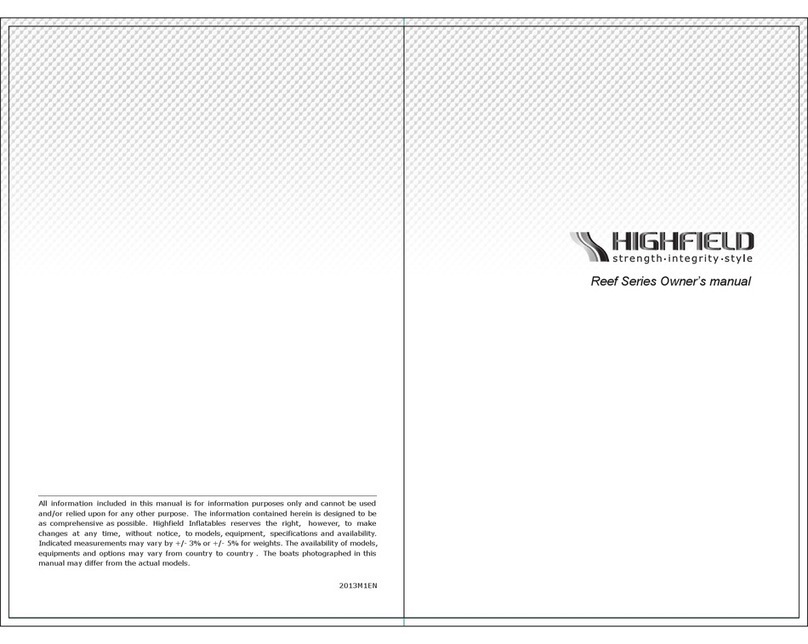
Highfield
Highfield Reef Series User manual
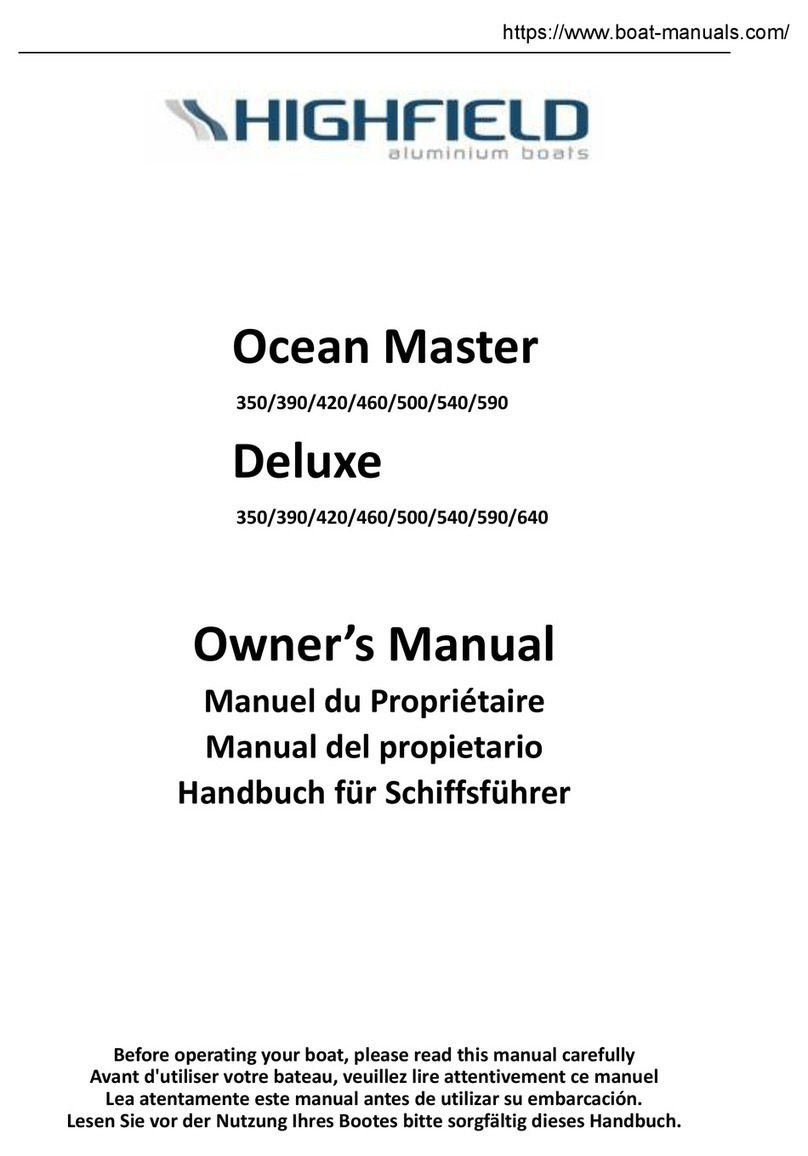
Highfield
Highfield Ocean Master 390 User manual

Highfield
Highfield PA500 User manual

Highfield
Highfield Patrol 420 User manual

Highfield
Highfield Classic 260 User manual

Highfield
Highfield Roll Up 200 User manual
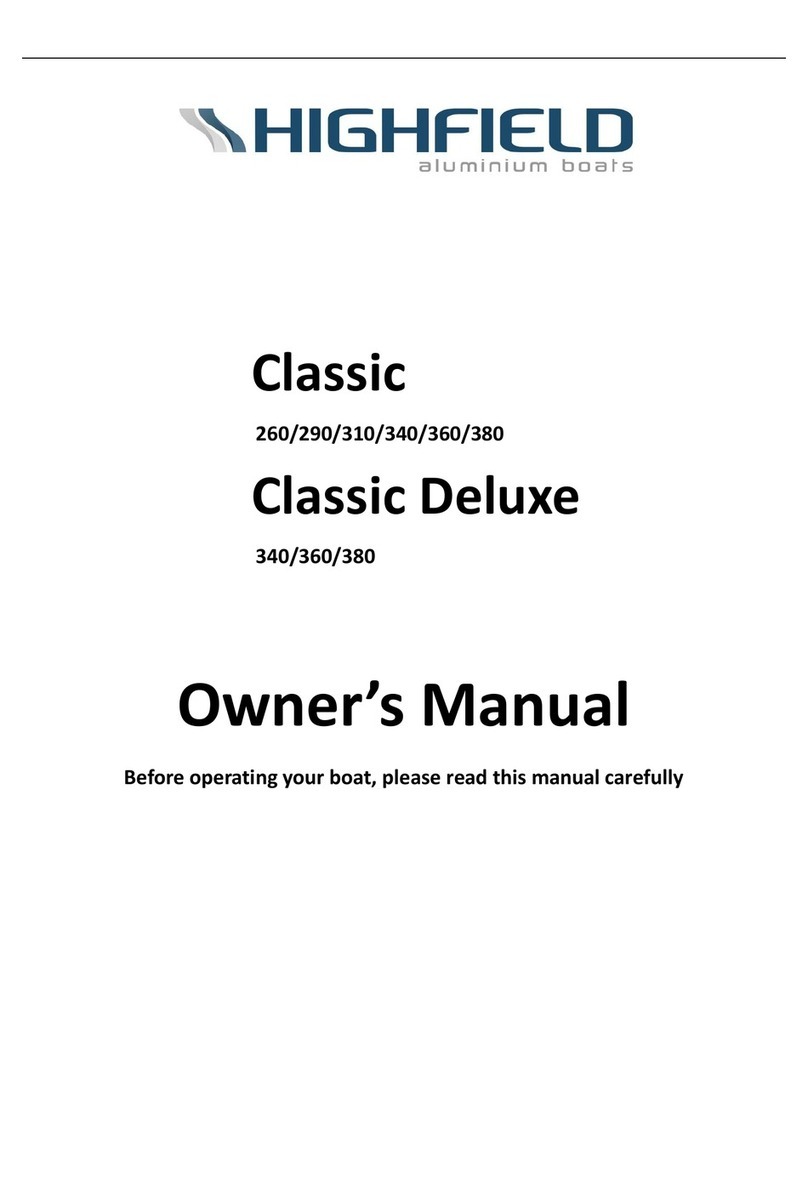
Highfield
Highfield Classic 260 User manual
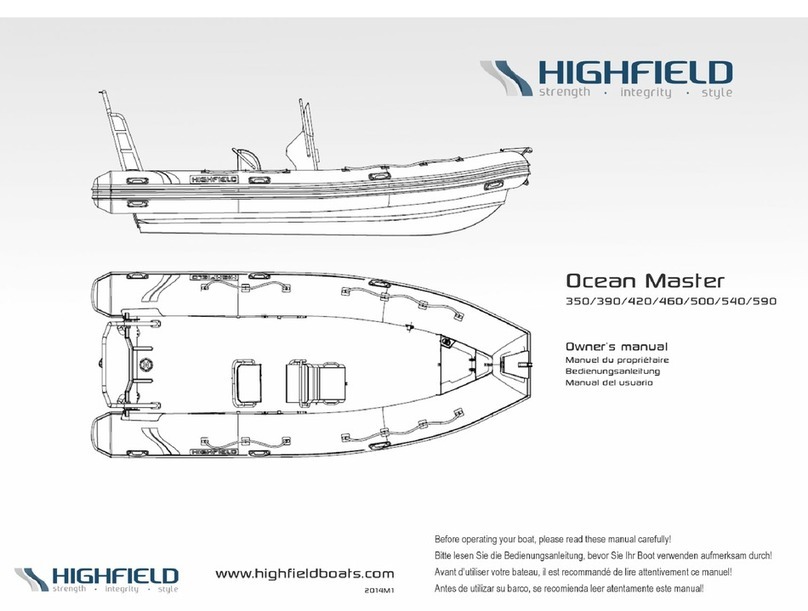
Highfield
Highfield Ocean Master 350 User manual

